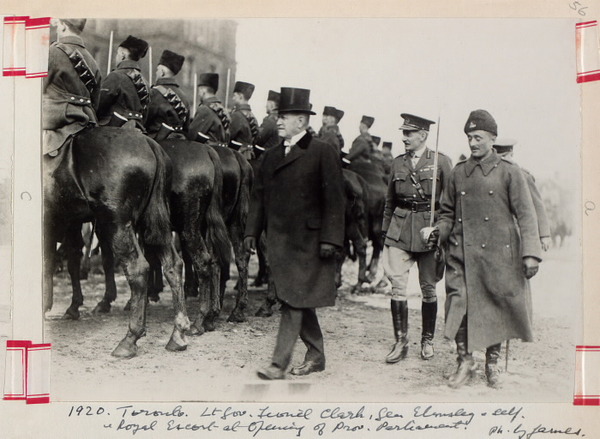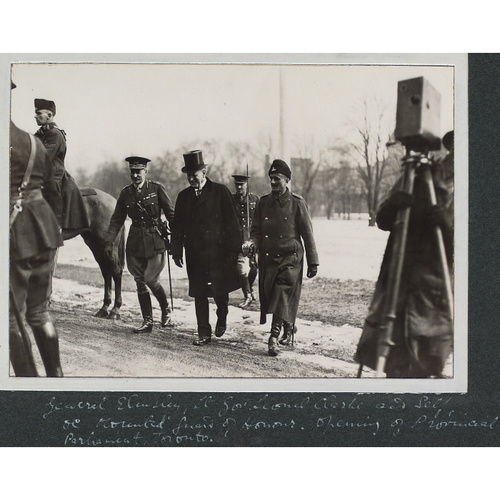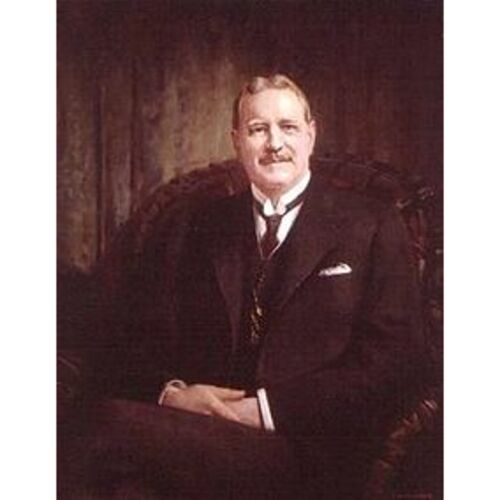CLARKE, LIONEL HERBERT, grain merchant and office holder, b. 20 July 1859 in Guelph, Upper Canada, son of William Clarke and Clara Piggott Strange, widow of William Dummer Powell; m. there 10 Feb. 1891 Anne Clara Gertrude Small, and they had three sons and a daughter; d. 29 Aug. 1921 in Toronto.
The son of an Irish-born physician turned magistrate and businessman, Lionel H. Clarke was educated at Trinity College School in Port Hope. Around 1878 he moved to Palmerston, northwest of Guelph, to pursue the grain business. About 1889 he expanded to Toronto, where by 1893 he had established L. H. Clarke and Company in partnership with Wilmot Deloui Matthews*. Operating out of offices in the new Board of Trade Building, in 1900 they founded a second firm, Canada Malting Company Limited. Despite tariffs that made Canadian malt uneconomical for brewers in the United States and western Canada and fires that destroyed the partners’ Palmerston works and in 1913 badly damaged Canada Malting’s Winnipeg plant, Clarke would focus on this trade for the remainder of his life. He achieved a respectable prosperity, which included appointments to the boards of other companies.
As he found economic security, he turned his attention to public life. Nominated by the Conservatives to contest Wellington North in the federal elections of 1891 and 1896, he lost each time. Business prevented him from running in 1900, but he helped secure the return of Edwin Tolton, a farmer and grain dealer, and remained involved in Conservative circles. His friendship with provincial leader James Pliny Whitney*, who became premier in 1905, led to his appointment in November 1908 to the Queen Victoria Niagara Falls Parks Commission. His passion for flowers resulted in gardens throughout the park, he protected its interests in negotiations with the hydroelectric companies at the falls, and he was a driving force behind the development of the riverside drive from Queenston. Federally, Clarke was a frequent adviser to Sir Robert Laird Borden*, whose government appointed him in 1917 to the Board of Grain Supervisors of Canada. Headed by Robert Magill, the board determined market needs, set prices and took orders, and regulated distribution within Canada until its replacement by the Canadian Wheat Board in 1919.
Despite his provincial and national interests, Clarke’s local contributions were his most significant legacy. In 1888 he had joined Toronto’s Board of Trade, which, within the year, became concerned about attempts by the Canadian Pacific and Grand Trunk railways to solidify their domination of Toronto’s waterfront. The city’s port and commercial districts were separated by a wide band of level crossings, where trains took several lives each year and frequently blocked the movement of goods to and from the wharves. The port had gone into decline, unable to compete with railways whose policies and rates, it seemed to board members, favoured Montreal over Toronto. The fire that destroyed 14 acres of the city’s core in 1904 provided an opportunity to deal with the crossings. The railways favoured bridges over their tracks. The board proposed a viaduct to raise the trackage, a plan for which was ready in June 1907, when Clarke was vice-president of the board and a member of its railway and transportation committee. Approved by city council in September, the plan was handed back to Clarke to take to the federal Board of Railway Commissioners, which ordered the railways to construct a viaduct. Much of the credit for this accomplishment went to Clarke during his presidency in 1908, though it would take another five years to forge an agreement.
The fire of 1904 had also forced the city to deal with the issues of water supply and sewage disposal, and thereby clear the way for federal support of harbour improvements. Silt and sewage blocked the wharves at a time when plans to expand the Welland Canal and build a deep waterway along the St Lawrence offered hope for Toronto’s development as a major distribution centre. The problem was driven home to Clarke when the master of a Scottish steamer appeared at his door in 1908 to complain that insufficient water at the wharves hindered the discharge of his cargo and about the lack of public docks and high handling charges. Along with such Board of Trade members as William James Gage, Clarke was instrumental in persuading federal and municipal officials to replace the existing harbour trust with a commission capable of building the needed public wharves, dredging a deeper harbour, and creating by means of infill industrial sites in Ashbridges Bay [see Sir John Alexander Boyd*; John Irvine Davidson*].
When Ottawa formed the Toronto Harbour Commissioners in May 1911, Clarke became its chairman, a position he would hold until his death. In 1912, expanding upon earlier proposals put forward by the railway companies, the Toronto Guild of Civic Art, and the Board of Trade, he directed the preparation of a plan for waterways, parks, and roads that would serve as a blueprint for development until the 1950s. Its details and implementation were left to a staff headed by engineer Edward Lancelot Cousins*, but Clarke brought vision to the project and played an important role in the meetings, inspections, and presentations that won financial support for a scheme estimated to cost more than $24 million. As industrial sites emerged, he advised the staff on leases. In 1913, as an alternative to the city’s purchase of the utility and street railway interests of Sir William Mackenzie, he surprised city council with proposals for a bold system of underground and surface lines emanating from the lakefront. Although the harbour commissioners and the railways reached an agreement that year on the viaduct and a new Union Station, Clarke would die before the completion of the viaduct and waterfront plans.
In addition to his parks and harbour work, Clarke served on the Toronto and York County highway commission from 1911 to 1913. With his wife he ran summer camps at Vineland, on the Niagara peninsula, for residents of the Toronto Boys’ Home. Clarke’s public and charitable involvement likely provided some distraction from the loss of his eldest son, Lieutenant Lionel Esmonde Clarke, in June 1916 in Belgium. His serious demeanour and forcefulness hid his warmth and sense of humour; known to shun publicity, he preferred to spend time with his family and pursue his hobbies of riding, hunting, angling, and reading. It surprised many when he was appointed lieutenant governor of Ontario on 27 Nov. 1919, though his populist approach suited the reform spirit of the recently elected United Farmers government of Ernest Charles Drury*. There was less formal ceremony at Clarke’s official residence in Chorley Park, which became a rallying point for interest groups who sought his recognition. As the Clarkes embraced a heavy schedule of public and social duties, their sense of humanity changed Ontarians’ perception of the role of lieutenant governor. The premier and Clarke disagreed publicly in 1920 over the government’s proposal to close Government House as a cost-saving measure, but Drury would remember him as “a gentleman and a man of taste.”
By the summer of 1921 stomach cancer had confined Clarke to his summer residence on Copperhead Island in Georgian Bay. He died at Government House in August and received a state funeral at St Paul’s Anglican Church. Few would have argued with the assessment by Senator Angus Claude Macdonell in 1918 that there was no more disinterested man in the service of his country than Lionel H. Clarke.
Lionel Herbert Clarke published an illustrated article on the Toronto waterfront development, “Putting a new front on Toronto,” in Canadian Magazine, 42 (November 1913-April 1914): 205-15.
AO, F 775, MU 2131, 1920, no.6; RG 3-4-0-11; RG 24-12; RG 80-8-0-803, no.5484. Toronto Port Authority Arch., RG 1 (records of the board of commissioners)/5, box 2, folder 9, A. C. Macdonell to L. H. Clarke; RG 3 (central registry files), box 148, folder 15, financial report by R. G. Dun and Co., 26 Jan. 1933; box 230, folders 22-23. Daily Mail and Empire, 28 Nov. 1919; 16 July, 30 Aug. 1921. Evening Telegram (Toronto), 26 Nov. 1913, 30 Aug. 1921. Globe, 29 Nov. 1919. Star Weekly (Toronto), 29 Nov., 6 Dec. 1919; 9 July 1921. Toronto Daily Star, 29-31 Aug., 30 Sept. 1921. Toronto Sunday World, 19 Aug. 1921. World (Toronto), 11 Feb. 1891. Canadian annual rev., 1913. Directory, Toronto, 1893-1921. E. C. Drury, Farmer premier: memoirs of the Honourable E. C. Drury (Toronto, 1966), 104. G. W. Englehardt, Toronto, Canada: the book of its Board of Trade . . . ([Toronto, 1897]). W. J. Gage, Address of Mr. W. J. Gage, president of the Board of Trade of the City of Toronto, delivered at annual meeting, January 19, 1911 ([Toronto, 1911]). C. M. Johnston, E. C. Drury: agrarian idealist (Toronto, 1986). Roy Merrens, “Port authorities as urban land developers: the case of the Toronto Harbour Commissioners and their outer harbour project, 1912-68,” Urban Hist. Rev. (Toronto), 17 (1988): 92-105. Ont., Legislature, Sessional papers, 1909, no.5: 5. Ontario Gazette (Toronto), 1900: 738, 1017. W. R. Plewman, Adam Beck and the Ontario Hydro (Toronto, 1947). G. H. Stanford, To serve the community: the story of Toronto’s Board of Trade (Toronto, 1974). Jeffrey Stinson and Michael Moir, Built heritage of the east bayfront (Can., Royal commission on the future of the Toronto waterfront, Technical paper, no.7, Toronto, October 1991). Toronto, Board of Trade, Annual report, 1895-1921 (mfm. at TRL); Board of Trade News, December 1919, September/October 1921 (copies at TRL). The Torontonian society blue book and club list (Toronto), 1921. Who’s who and why, 1921.
Cite This Article
Michael B. Moir, “CLARKE, LIONEL HERBERT,” in Dictionary of Canadian Biography, vol. 15, University of Toronto/Université Laval, 2003–, accessed December 31, 2025, https://www.biographi.ca/en/bio/clarke_lionel_herbert_15E.html.
The citation above shows the format for footnotes and endnotes according to the Chicago manual of style (16th edition). Information to be used in other citation formats:
| Permalink: | https://www.biographi.ca/en/bio/clarke_lionel_herbert_15E.html |
| Author of Article: | Michael B. Moir |
| Title of Article: | CLARKE, LIONEL HERBERT |
| Publication Name: | Dictionary of Canadian Biography, vol. 15 |
| Publisher: | University of Toronto/Université Laval |
| Year of publication: | 2005 |
| Year of revision: | 2005 |
| Access Date: | December 31, 2025 |






